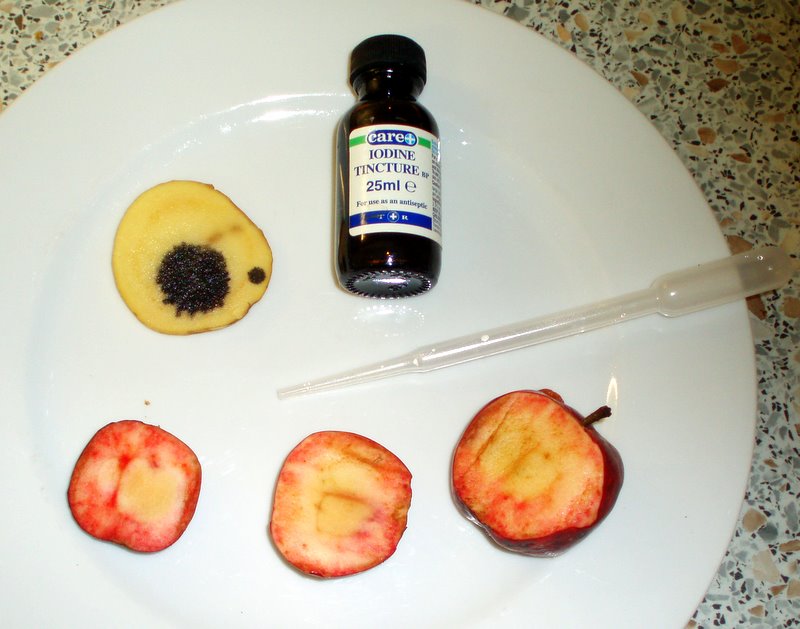How
to do an Iodine Test for Starch
This is a way to tell if your apples are ripe or not. It relies on the
fact that unripe apples contain starch granules which have not yet been
converted to sugar by natural enzymes in the fruit.
Once the fruit is ripe, all that starch will have been changed
to sugar and will be undetectable. One of the properties of
iodine solution is that it reacts with starch to give a blue-black
colour, but it doesn't react with sugars. Many mid and late
season apples are not physiologically ripe when they are picked or fall
from the tree, and they need a period of storage before all the starch
is converted into sugar and are at peak flavour. This is a way to
monitor that process.
You need a bottle of 'tincture of iodine' which you can most easily get nowadays from an online supplier, and ideally a small dropping
pipette, as in the picture.

Slice the apple and drip a drop of iodine onto the cut
surface. In a few minutes it will turn dark blue or black if there is
significant starch present (unripe fruit). If not, the drop will just
leave a slight yellow
stain of the apple flesh as in the bottom row of the picture (ripe
fruit). The sample at top left is a 'positive control' i.e. a
potato or an apple known to be unripe, which shows the characteristic
blue-black
reaction. That shows that your iodine is OK and is doing its stuff.
(BTW the apples are Foxwhelp and Frederick which have notably
red-tinged flesh below the skin).
A note about iodine supply
Tincture of iodine
isn't so readily available on the British High Street as it once was.
Newer
types of topical antiseptic have taken its place. But you can still buy
it from a few mail order pharmacists online - for instance the "Bells"
brand still seems to be available in the UK. You can also buy it from
some home brew suppliers since it's used to test for starch
conversion during grain malting and mashing.
However, avoid formulations of Povidone-Iodine aka Betadine.
These don't work in the starch test. Although they do contain plenty of
iodine and so work as antiseptics, the iodine is already
complexed with PVP (povidone) and so it's no longer free to form a
complex with apple starch. There is a slight reaction, but it's very
very weak and doesn't have the sensitivity that we need.
If you
are semi-professional and want to do lots of iodine tests, you'd be
better off to make up your own solutions. There are many recipes used
by commercial growers, but here's a link to just one (the Cornell test)
which also gives a rating scale for starch conversion depending on
colour intensity. It's used by commercial dessert apple growers to tell
when to pick their apples for controlled-atmosphere store.
Back
to my Contents Page.
Last revised 1st September 2019
